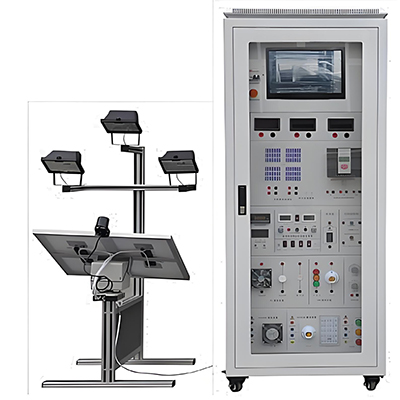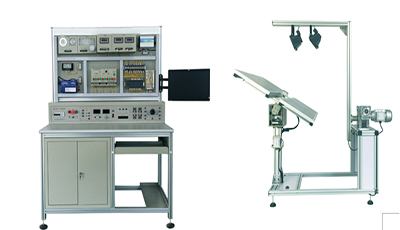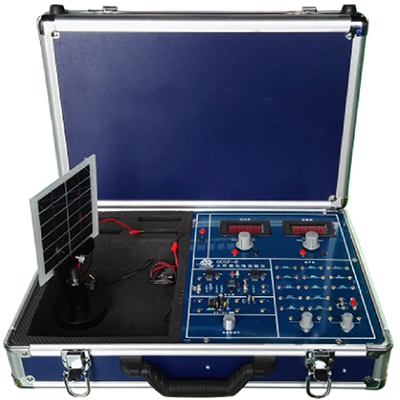GL-GF-1 Solar photovoltaic power generation training equipment mainly includes solar panels, intelligent controllers, maintenance-free batteries, electrical distribution and other components, which help students understand the principles of solar photovoltaic power generation and master engineering application capabilities such as system configuration, structure and composition.
GL-GF-1 solar photovoltaic power generation training equipment
Ⅰ、 Overview
Solar photovoltaic power generation has the advantages of no exhaustion, no pollution, and wide resource distribution. Solar power generation is to convert solar energy into direct current electricity and store it through the photoelectric effect of solar panels. It is widely used in communications, microwaves, optical cable transmission, railway communications, highway communications, lighting, landscape, mobile power devices, hydrological observation systems, meteorological and seismic stations, etc. Due to its environmentally friendly and pollution-free characteristics and its advantages of no exhaustion, no pollution, and wide resource distribution, it has become an energy source that people pay more and more attention to.
GL-GF-1 solar photovoltaic power generation training equipment mainly includes solar panels (including brackets), intelligent controllers (with data communication), maintenance-free batteries, electrical distribution and other components to help students understand the principles of solar photovoltaic power generation and master the engineering application capabilities of system configuration, structure, composition, etc.
Ⅱ、Device features
1. Lamps with luminescence (spectrum) close to sunlight are used to simulate sunlight. The training project can be carried out at any time. Therefore, it does not need to be restricted by weather changes.
2. The project has strong practical value. The solar panels (20W*4), intelligent controllers, batteries, and street lights used are the same as those in the field application, which can enable students to deeply understand the field application of solar photovoltaic power generation.
3. The various parts of the GL-GF-1 solar photovoltaic power generation training equipment are completely independent. Students can connect them by themselves according to their understanding of the application of solar photovoltaic power generation during the training process.
4. Standard industrial solar panels are used, which can be placed indoors and outdoors, and the angle can be adjusted.
5. A variety of simulated application training is provided: solar street lights, solar warning lights and inverters, etc.
6. Solar panels can automatically track the light chasing system.
7. The all-aluminum alloy design is adopted to meet the training needs of vocational and technical colleges. All training devices are installed on the mesh plate. The training hours are hands-on practice operations. The mesh plate size is 1200mm*600mm.
Ⅲ、Technical indicators
1. Input power: 380V±10% 50Hz
2. Capacity:<1000VA
3. Working environment: temperature -10℃~+40℃, relative humidity<85% (25℃), altitude <4000m
4. Training platform: length 1280mm×width 600mm×height 1680mm; sun tracking system: length 900mm×width 1400mm×height 1640mm
5. Weight:<120KG.
Ⅳ、Main configuration of the system
Includes: solar cell components, sun tracking system (sun tracking device, tracking device control system, light sensor, analog light source device), measuring instrument power supply (DC voltage, ammeter, temperature and humidity meter, AC multi-function meter, constant voltage and current power supply), photovoltaic controller, battery, inverter controller (off-grid, grid-connected), training platform, mesh plate, experimental management software.
1. Solar cell module
1) Design capacity 20*4Wp;
2) Adopt high-efficiency monocrystalline silicon solar cell module, in line with IEC61215:1993 standard;
3) The protection level of the battery module is not less than IP65, and the operating temperature range is -20℃~+60℃;
4) The battery module meets the requirements of national mandatory standards.
5) The solar cell panel adopts array assembly form, mainly composed of 4 small solar cell panels, which can realize the parallel connection and series connection of solar cell panels, and then provide two solar cell panel networking methods of high current or high voltage.
6) The parameters of the provided panels are as follows:
Maximum output power: 4*20W
Open circuit voltage: 21.87V (parallel), 4*18V (series)
Short circuit current: 4*0.72A (parallel), 0.72A (series)
2. Sun tracking system
1) Solar tracking device
The photovoltaic tracking device is mainly composed of photovoltaic cell components, light sensors, light sensor control boxes, horizontal and pitch motion mechanisms, micro switches, base brackets and other equipment and devices.
2) Tracking device control system
The control system provides manual and automatic control modes, which can control the different trajectories of the light source and the positions of the horizontal and pitch motion mechanisms, so that students can fully understand the tracking system. The system reserves multiple structures for secondary development.
The sun tracking control system uses Siemens programmable controller CPU226 as the control host and provides a corresponding PLC development environment.
A. Programmable controller CPU226 (AC/DC/RELAY) host
B. Integrated digital I/O (24 digital inputs/16 digital outputs)
C. Two RS-485 communication ports
D. 2-phase high-speed counter with a maximum rate of 100KKz TTL~24VDC high-speed counting
E. Built-in 2-way high-speed pulse output ports,
F. Contains PPI communication; supporting PC/PPI programming cable.
3) Light sensor
A. Tracking mode: dual-axis fully automatic tracking
B. Accuracy: ±0.5°
C. Horizontal rotation angle: 360°
D. Pitch angle: 180°
E. Controller power supply: DC 12V
F. Motor power supply: DC 12V
G. Adopt 40*80mm aluminum alloy design
4) Analog light source device
Use 2 300W projection lamps installed on the bracket, voltage 220V, maximum power 300W. The actuator adopts AC motor control, which can vividly simulate the trajectory of sunlight from east to west to simulate the composition of the solar system.
3. Measuring instruments
1) DC voltage and current meter
A DC digital voltage meter, designed with a high-performance AD converter and a high-speed MPU unit, realizes the human-computer dialogue function control mode through keying and digital display windows. It has automatic and manual ranges, and the measurement range is: 0~300V. The measurement accuracy is 0.5 level.
A DC digital milliammeter, designed with a high-performance AD converter and a high-speed MPU unit, realizes the human-computer dialogue function control mode through keying and digital display windows. It has automatic and manual ranges, and the measurement range is: 0~5A. The measurement accuracy is 0.5 level.
2) Thermohumidity meter
Temperature measurement range: -40~120°C, measurement accuracy is 0.5 level.
3) AC multi-function meter
Designed with 24-bit dedicated DSP, 16-bit high-precision AD converter and high-speed MPU unit, it realizes the human-machine dialogue function control mode through key control and digital display window.
4) 0-30V/2A regulated constant current power supply
4. Photovoltaic controller
Light control output + multiple types of timing output, rated voltage: 12V, rated current is 10A, load normally open output; battery overcharge, over-discharge protection, load overvoltage, overload, short circuit protection, night anti-reverse charging protection, output short circuit protection, temperature compensation.
5. Valve-regulated lead-acid battery:
1) Low self-discharge rate;
2) Long service life;
3) Strong deep discharge capability;
4) High charging efficiency;
5) Wide operating temperature range;
6) Operating temperature: -18~60℃;
7) Capacity 12AH
6. Inverter controller
1) Off-grid inverter 300W
A. Pure sine wave output (distortion rate ≤4%);
B. With overvoltage/undervoltage/short circuit/overload/overtemperature protection;
2) Grid-connected inverter 300W
The grid-connected inverter has a DC-DC and DC-AC two-stage energy conversion structure. The DC-DC conversion link adjusts the working point of the photovoltaic array to track the maximum power point; the DC-AC inverter link mainly makes the output current in phase with the grid voltage and obtains unity power factor at the same time.
7. Mesh plate
Mesh plate size: length 1200mm*width 600mm.
8. Touch screen
Provide a 10-inch touch screen, on which the operation of the solar dual-axis tracking device can be controlled and instrument data can be monitored
V、Training projects
1. Solar panel characteristic experiment series
1) Solar panel I-V characteristic test experiment
2) Short-circuit current test experiment
3) Open circuit voltage test experiment
4) Load characteristic test experiment
5) Maximum output power test experiment
6) Functional relationship between open circuit voltage and relative light intensity
7) Solar cell light energy conversion test experiment.
8) Solar cell series and parallel connection experiment
9) Solar module output experiment
10) Test experiment on light wave photovoltaic conversion efficiency under different weather and sunshine intensity.
11) Test experiment on photovoltaic energy conversion under solar orbit change in different seasons.
12) Test on photovoltaic energy conversion under ambient temperature change in different seasons.
2. Solar automatic tracking experiment series
1) Experiment on the principle of the sun-tracking system
2) Experiment on the impact of the environment on photovoltaic conversion
3) Solar light-controlled tracking experiment
3. Solar battery controller experiment series
1) Solar battery charging control experiment
2) Controller charging and discharging protection experiment
3) Battery voltage and current test experiment
4) Control battery current inflow and output experiment
5) Controller light-controlled-time control output experiment
6) Waveform test of battery charging entering the PWM modulation stage
7) Load normal, overload, short circuit, and operation test experiment
8) Operation test experiment of household and light-controlled control modes
4. Solar application experiment series
1) Solar AC and DC fan experiment
2) Application and principle of solar street lights
3) Solar street light wiring training
4) Examples of solar street light applications
5) Application and principle of solar warning lights
6) Solar warning light wiring training
7) Solar variable impedance load experiment
5. Solar photovoltaic inverter experiment series
1) Principle of inverter power supply
2) Wiring training of inverter power supply
3) Off-grid inverter experiment
4) Grid-connected inverter experiment
6. PLC programming training
1) PLC manual programming experiment of dual-axis tracking device
2) PLC automatic programming experiment of dual-axis tracking device
7. Configuration software programming
8. Power control monitoring software programming

Synchronous PC version:
GL-GF-1 solar photovoltaic power generation training equipment https://www.biisun.com/home/category/detail/id/146.html


 Italian
Italian German
German Russian
Russian Turkish
Turkish Portuguese
Portuguese Spanish
Spanish French
French




